The planet is getting hotter. According to the World Meteorological Organization, 2011-2020 was the warmest decade since records began[1]. We are all aware, by now, of the climate emergency- and of the fact that we have only ten years, at most, before reaching the point of no return.
While the COVID-19 crisis this year has had a devastating effect on society and global economies, it has had a positive impact on carbon emissions and has shown us all that it is possible to reduce our carbon emissions drastically. The goal now is to find a happy balance as we reignite global economies.
Environmental impact of COVID-19 pandemic[2]

One thing is clear; governments cannot solve the problem on their own. So how can the investment industry play its part?
The central role of asset management
By the end of 2019 close to $90trn of assets were being managed by asset managers around the world[3]– to put that into perspective, it is approximately five times the GDP of all the countries in the European Union combined! With such large amounts of money to invest, asset managers have a real opportunity to drive sustainable change around the world.
As recently as four years ago, environmental, social and governance (ESG) investing was quite a niche approach, popular in Europe but not widely embraced…however it is estimated that the incorporation of ESG data in investment decisions has almost doubled since then – now reaching just over $40trn, or almost 45% of all assets under management.
Much of this growth stems from investor demand and increasingly from the requirements of regulators around the world, whether local schemes or regional initiatives such as the EU action plan.
Growing investment use of ESG data
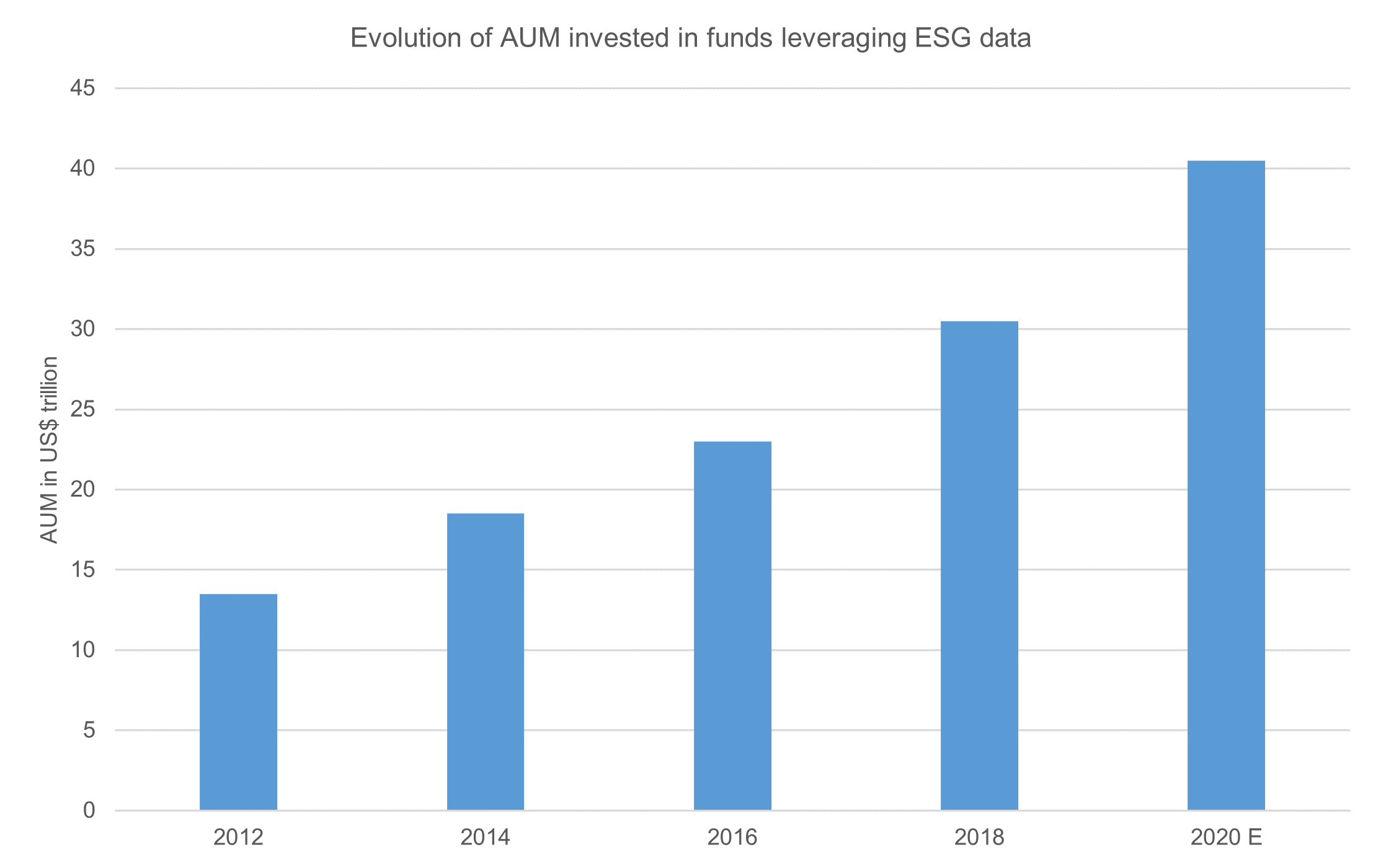
Source: GSIA, Opimas
Is climate truly an investment topic
Climate change is not just a matter for the media, young people or environmentalists; it has become a key topic for investors around the world. There are several reasons for this shift, the first being a question of investment risk management as climate change is closely associated with asset-specific risks. Identifying these risks and accounting for them in the investment process will lead to better long-term investment decisions.
Climate-associated risks
Transition risk: assets at risk of being negatively impacted by incoming climate regulation or low carbon technologies e.g. coal mines
Physical risks: assets at risk of being negatively impacted by the increasingly severe weather related events
On the upside, the investment opportunities arising from the energy transition could actually outweigh climate-related risks in the long term.
This leads us to the second reason for climate change to be considered an investment topic – investors do not like to miss return opportunities and climate investments have shown some promise in terms of their risk-return ratio.
An analysis of MSCI climate indices over the past five years is a simplistic indicator of this, across all time periods and geographies, the climate version of the index has shown consistent outperformance compared to the parent index.
Positive Climate Index Performance
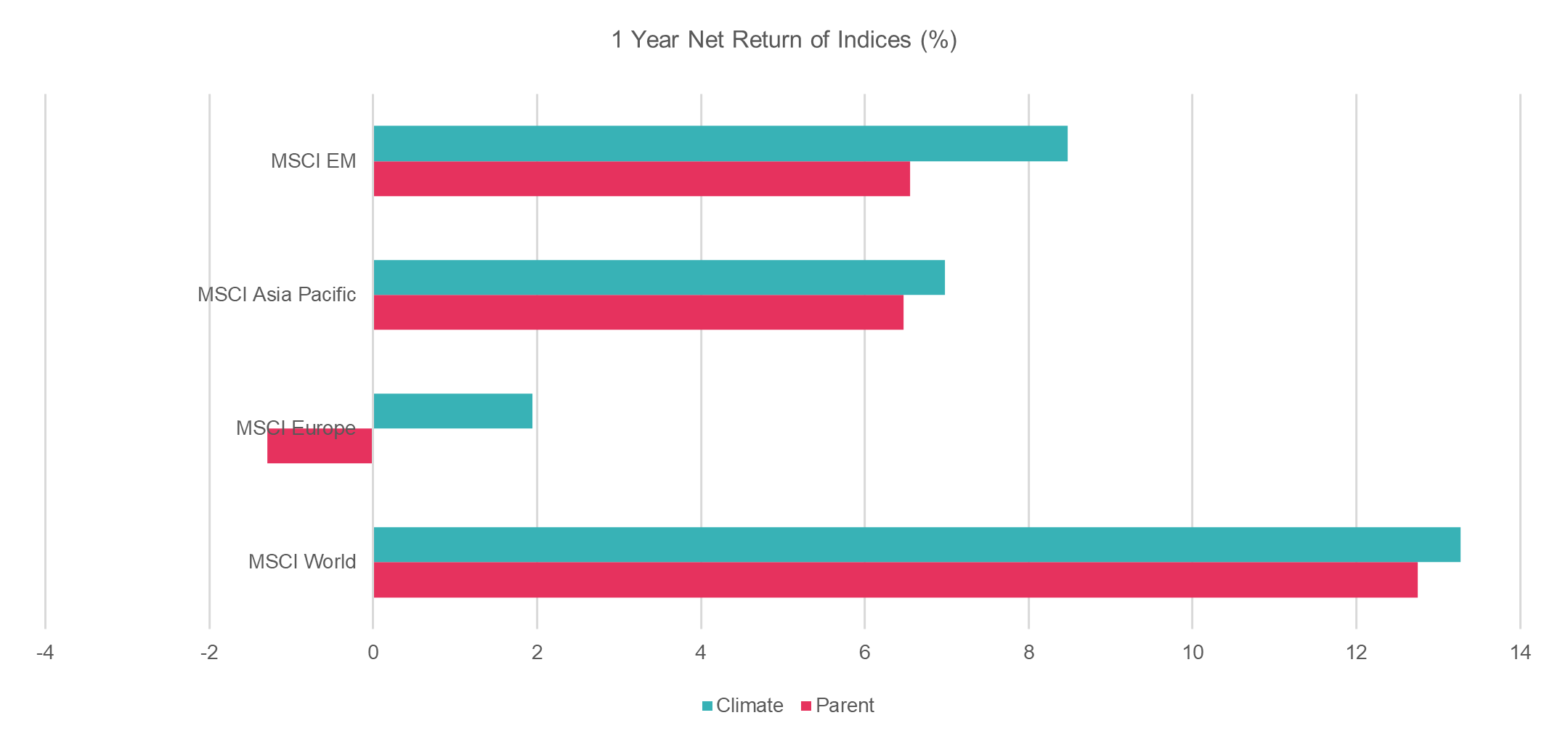
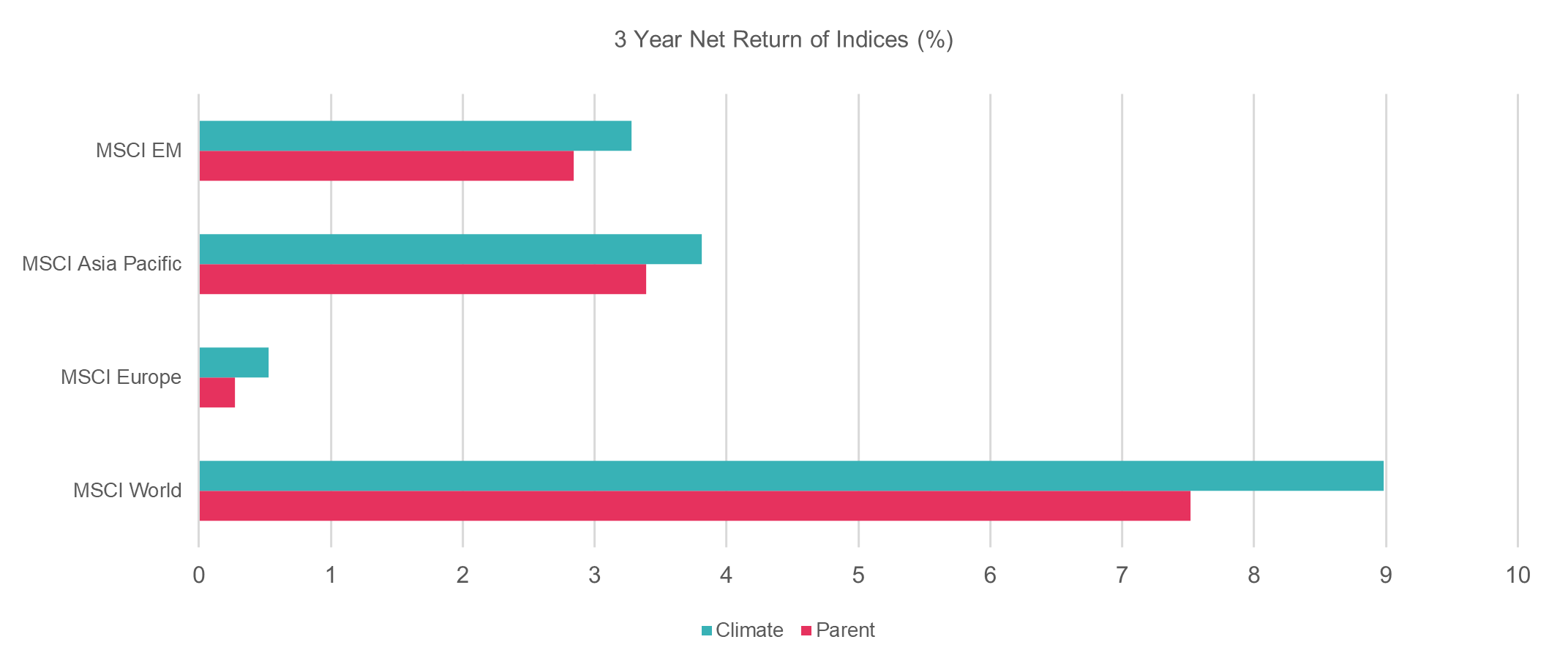
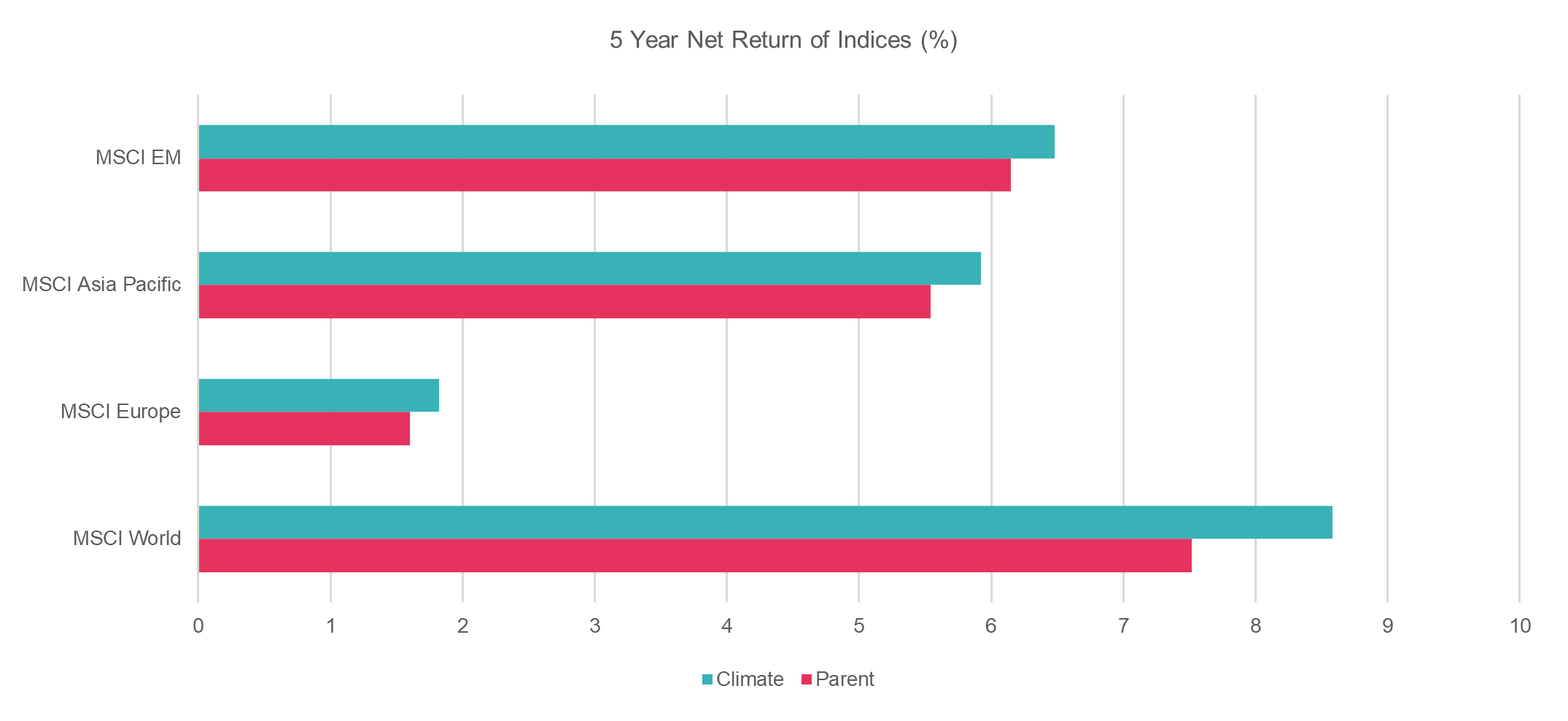
Past performance does not guarantee and is not indicative of future results
Source: MSCI as at 31 July 2020 (Indices shown are MSCI World Climate Change Index, MSCI EM Climate Change Index, MSCI Europe Climate Change Index and MSCI AC Asia Pacific Climate Change Index)
A further reason for the climate to be an important consideration for investors is the evolving regulatory landscape. In 2015, the French Energy Transition for Green Growth Act set a global precedent by requiring investors to be transparent about the climate impacts of their investments.
In other countries where there is no equivalent regulation, local industry bodies are stepping in with recommendations. For example, the Swiss industry association of asset managers SFAMA together with the Swiss Sustainable Finance organisation for sustainable investment recently published recommendations for the implementation of ESG concepts, and in the UK, the FCA’s Climate Financial Risk Forum has now published a guide to help the investment industry address climate-related risks.
The practicalities of considering climate
Investors looking to incorporate climate into their portfolios historically focused on impact investing strategies or active investment solutions. The primary reason for this in the past was the inability of index approaches to stock pick or under/overweight companies. While impact or active approaches are good for some investors for certain aspects of their investment strategy, they are not always the answer.
Index approaches to climate investing do exist, and have done for some time; in fact, Amundi was at the forefront of low carbon index innovation when they co-developed the MSCI Low Carbon Leaders index series with pension funds, FRR and AP4 in 2014.
The indices were a groundbreaking development when they were created, but improvements in data quality and availability have now opened the door to a new generation of climate indices, which can consider indirect emissions and forward-looking climate commitments alongside historical data. With the further addition of comprehensive climate index labels from the European Union, investors are able to use index investing to incorporate climate goals in their portfolios more effectively.
The EU benchmark labels
In 2018, the EU assembled the Technical Expert Group, a panel of experts from the investment industry, academia and sustainability practitioners to develop climate index labelling – resulting in the EU Climate Transition Benchmark (CTB) and Paris-Aligned Benchmark (PAB)[4]labels, the first pan European labels for sustainable investment indices. In doing so, the EU has provided investors with a clear and transparent framework for sustainable investing and highlighted the important role of index management in the transition to a low carbon economy.
The PAB and CTB labels require specific levels of “self-decarbonisation” of the index year-on-year as well as ambitious carbon intensity reductions versus the parent index. PAB labelled indices also require specific activity exclusions. Together, the benchmark labels offer a structure for index providers and asset managers to facilitate widespread, cost-effective climate investing. As climate investing becomes more accessible, the greater the impact it will have.
Amundi’s climate ETF range
Having been instrumental in developing the early low-carbon indices, and with a long-standing commitment to sustainability, Amundi was one of the first asset managers to launch ETFs aligned to the new EU climate indices.
The range covers investors’ core geographies with PAB labelled funds alongside a series of climate change ETFs that are expected to meet the criteria of the CTB label[5]. Therefore, allowing investors to incorporate climate at the heart of their portfolios simply, cost-effectively and in a way that matches their objectives.

The Amundi ETF climate solutions use indices that follow comprehensive positive- and negative-screening, reweighting and scoring methodologies to deliver on their carbon reduction objectives.
Additionally, they use historical data on emissions Scope 1 (direct), Scope 2 (purchased electricity) and Scope 3 (all other indirect emissions) of greenhouse gas emissions to explicitly allocate to the most climate positive companies. This backwards-looking analysis is combined with forward-looking approaches that consider company strategy and the transition risks associated with carbon emissions.
EU Climate Benchmark Methodology
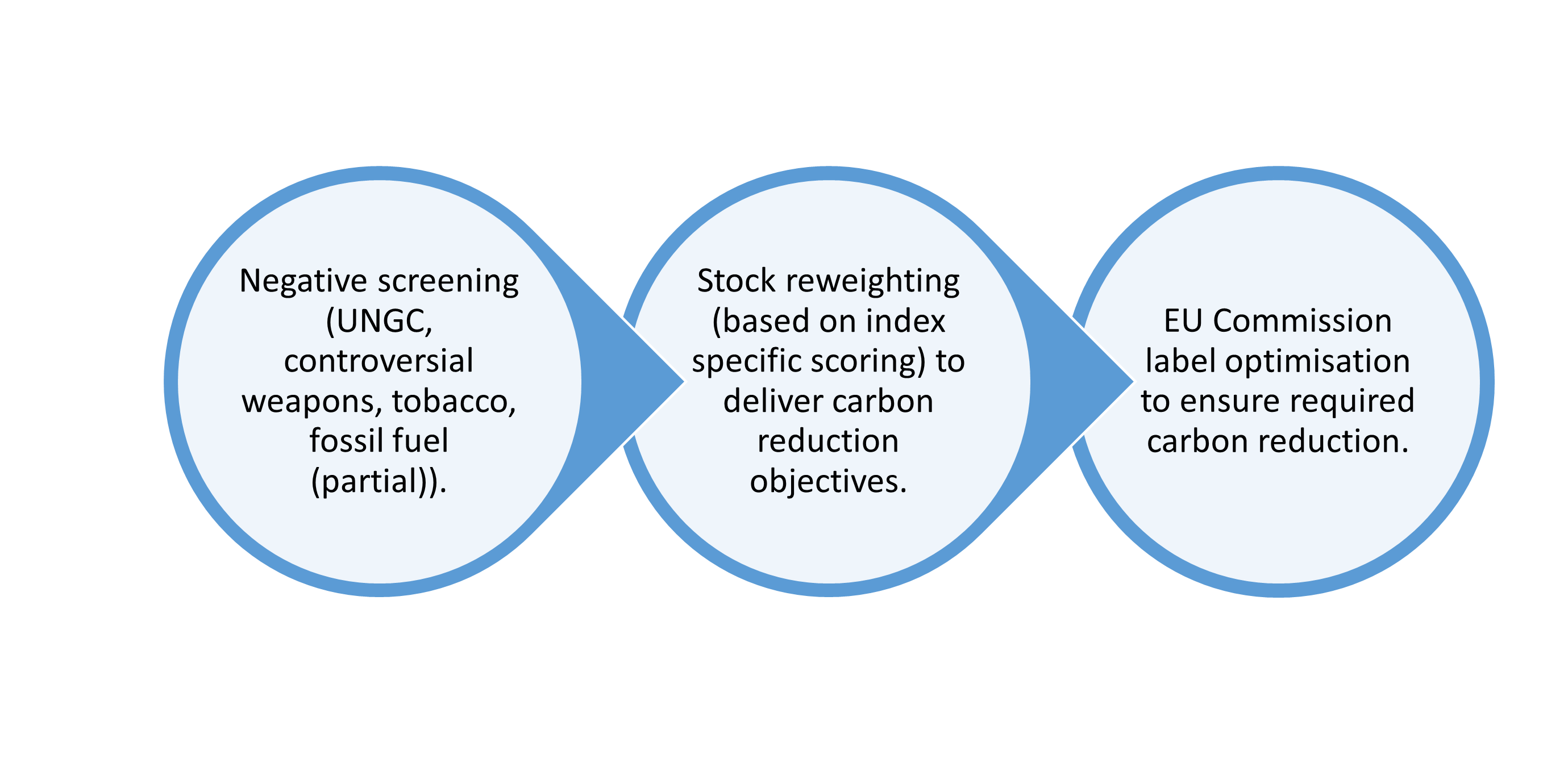
Driving impact with climate index investing
When selecting an index approach to climate investing, the first step for investors is to choose a suitable climate index, however, equally important is the selection of an asset manager. Identifying a manager who has a robust engagement and voting strategy aligned with the goals of the index can play a key role in achieving climate investment goals. For example, an asset manager who manages a climate ETF but votes against climate-related shareholder proposals or does nothing to discourage lobbying with negative environmental consequences would ultimately disappoint an investor seeking real climate impact.
Amundi has a comprehensive engagement strategy comprising continuous engagement, an active voting policy (which saw at least one Amundi vote against management in 71% of shareholder meetings in 2020[6]) and targeted impact engagement on core themes such as environmental strategy, energy use and biodiversity. It is with this foundation that Amundi launched the Euro iStoxx Climate Ambition ETF which was consciously designed to encourage impact through engagement. By systematically overweighting securities with Science Based Targets, the index was designed to incentivise companies to commit to the Science Based Target initiative[7] and disclose their carbon footprint reduction emission plans.
Engagement or divestment?
According to the PRI in 2015[1], one of the key reasons investors use active approaches to address climate concerns is the inability of index funds to exclude securities.
While divestment sends a clear signal that a company or sector is not doing enough on ESG issues, it quashes engagement by that investor and means there is one less responsible shareholder to put pressure on the company.
One downside of divesting from the oil and gas sector, for example, is investors no longer engage with firms large enough to pour resources into renewables projects.
Investors may prefer to continue to have exposure to controversial sectors while ensuring that their asset manager votes and engages on these holdings to drive sustainable change.
Over recent years asset manager engagement has resulted in tangible change across a range of sectors, container shipping companies committing to net-zero targets, and food and beverage manufacturers reporting on scope 3 emissions. Also, oil and gas companies have committed to link executive pay to climate targets, according to the Climate Action 100+ 2019 Progress Report[8].
Exclusions, divestment and engagement can all be achieved in passive investment strategies, and it is important to select a fund manager that not only “talks the talk” on ESG issues, but also “walks the walk”.
Responsible investing at Amundi ETF, Indexing and Smart Beta
Amundi was established in 2010 with responsible investing as a core belief. One of the founding signatories of the UN Principles for Responsible Investment (PRI),[9] in 2020 Amundi was awarded an A+ across all categories in the PRI10 assessment. Amundi offers a broad range of ESG investment solutions and has an extensive engagement and voting policy, applied equally across both active and index.
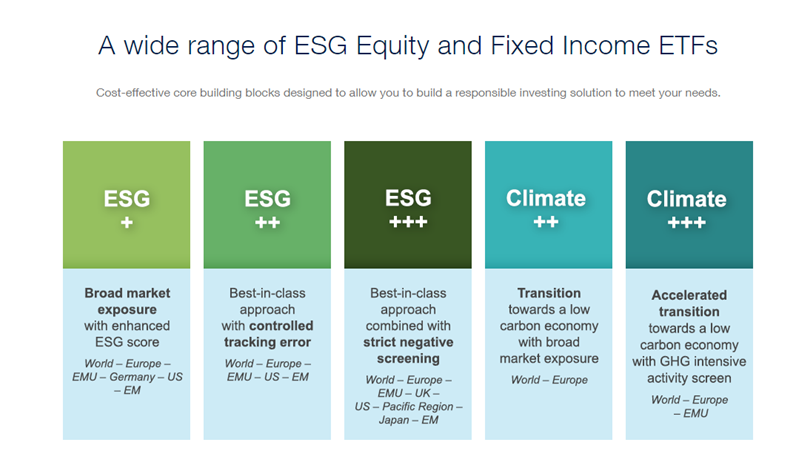
Amundi was awarded a BB rating and ranked fifteenth in the 2020 ShareAction UK report which analysed the world’s largest asset managers on their approaches to responsible investing. This was the highest score awarded to an asset manager ranking in the top ten by AUM.
For more information about using ETFs to make a positive climate impact, visit amundietf.com/responsibleinvesting or email us at info-etf@amundi.com.
[1] Source: World Meteorological Organization, 14 January, 2021
[2] Source: Updated from Le Quéré et al. Nature Climate Change (2020), excluding international and avaiation and shipping for country emissions
[3] BCG article, Global Asset Management 2020: Protect, Adapt, and Innovate (May 19, 2020)
[4] European Commission Delegated Regulation of 17.7.20 supplementing regulation (EU) 2016/1011 as regards minimum standards for EU Climate Transition Benchmarks and EU Paris-aligned Benchmarks. This regulation sets out minimum technical requirements for EU Climate Benchmarks, as well as a number of environmental, social and governance (ESG) disclosure requirements.
[5] Pending index compliance with the CTB label, or an index change
[6] Amundi 2020 Engagement Report
[7] For more information visit sciencebasedtargets.org
[8] Amundi is a signatory of Climate Action 100+, an initiative bringing together over 450 investors with over $40 trillion in AUM to tackle climate changes by influencing the behaviour of 161 of the world’s largest greenhouse gas emitters. Visit climateaction100.wordpress.com for more information.
[9] The PRI was founded in 2005 with Credit Agricole Asset Management as a founding signatory. Amundi was borne of the merger of Crédit Agricole Asset Management with Société Générale Asset Management in 2010.
[10] For more information visit unpri.org and view the 2020 transparency reports.
Important information
This promotion is issued by Amundi (UK) Limited, registered office: 77 Coleman Street, EC2R 5BJ. Amundi (UK) Limited is authorised and regulated by the Financial Conduct Authority under number 114503.
This document is not intended for citizens or residents of the United States of America or to any “U.S. Person” , as this term is defined in SEC Regulation S under the U.S. Securities Act of 1933. The “US Person” definition is provided in the legal mentions of our website www.amundi.com. Investors are subject to the risk of loss of capital. Promotional & non-contractual. Information which should not in any way be regarded as investment advice, an investment recommendation, a solicitation of an investment offer, or a purchase of any financial securities. The accuracy, completeness and relevance of the information, forecasts and analyses provided are not guaranteed. They have been prepared from sources considered reliable and may be altered without prior notice. The information and forecasts are inevitably partial, provided on the basis of market data observed at a particular moment, and are subject to change. This document may contain information from third parties that do not belong to Amundi (“Third Party Content”). Third Party Content is provided for information purposes only (for illustration, comparison, etc.). Any opinion or recommendation contained in Third Party Content derives exclusively from these third parties and in no circumstances shall the reproduction or use of those opinions and recommendation by Amundi AM constitute an implicit or explicit approval by Amundi AM. Information reputed exact as of May 2021.
Reproduction prohibited without the written consent of the Management Company. Amundi ETF designates the ETF business of Amundi Asset Management. This document was not reviewed/stamped/approved by any Financial Authority. Amundi ETF funds are neither sponsored, approved nor sold by the index providers. The index providers do not make any declaration as to the suitability of any investment. A full description of the indices is available from the providers. This document is being issued inside the United Kingdom by Amundi which is authorised by the Autorité des marchés financiers and subject to limited regulation by the Financial Conduct Authority (“FCA”). Details about the extent of regulation by the FCA are available on request. This document is only directed at persons who are professional clients or eligible counterparties for the purposes of the FCA’s Conduct of Business Sourcebook. The investments described herein are only available to such persons and this document must not be relied or acted upon by any other persons. This document may not be distributed to any person other than the person to whom it is addressed without the express prior consent of Amundi.
Amundi Asset Management, French “Société par Actions Simplifiée” - SAS with capital of €1,086,262,605 - Portfolio Management Company approved by the AMF (French securities regulator) under no. GP 04000036 - Registered office: 90 boulevard Pasteur, 75015 Paris - France. 437 574 452 RCS Paris.



